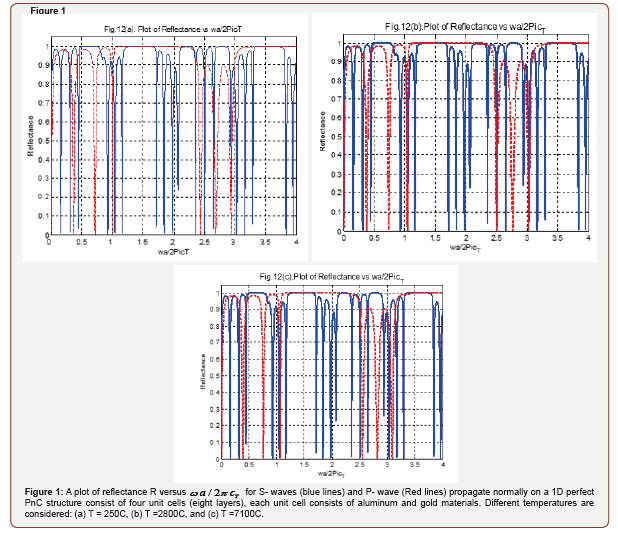 Mini Review
Mini Review
Clear Influences of Temperature on Phoninic Band Gaps
Ahmed Mehaney* and Arafa H Aly
Department of Physics, Faculty of Sciences, Beni-Suef University, Egypt
Ahmed Mehaney, Department of Physics, Faculty of Sciences, Beni-Suef University, Egypt.
Received Date: March 20, 2019; Published Date: April 01, 2019
Background on qT −X Family of Distributions Induced by V
The influences of temperature on the band gap structure can appear more clearly in the case PnCs with high melting point materials as shown in Figure 1. Aluminum/gold PnCs experiences significant effect by increasing temperature change. From these results, several factors related to temperature will be change. For instance, the thermal conduction in silicon PnCs [1-3] can be change according to these results, where the dispersion relations depend on the frequency band gap values. Also the thermal conductivity of the PnC structure can be change depend on the generated localized modes within the band gap. Since the thermal conductivity of any structure is represented by the temperature gradient at which the heat is absorbed or lost. Therefore, the localized states within the band gaps will directly change the temperature gradient, in turn, will change the whole thermal conductivity of the PnC structure. The elastic constants are related to the isothermal constants by the formula [1-3] (Figure 1),


where the superscripts σ and θ indicate adiabatic and isothermal constants,β the thermal expansion coefficient, B the bulk modulus(B = λ + 2 / 3μ ), θ the absolute temperature in kelvins, ρ the density, and Cν the specific heat at constant volume. Eq.24 indicates that there is a difference between λσ andλθ should be taken into account.
Acknowledgement
None.
Conflict of interest
No conflict of interest.
References
- AH Aly, A Mehaney, E Abdel Rahman (2013) Study of physical parameters on the properties of phononic band gaps. International Journal of Modern Physics B 27: 1350047.
- Ahmed Mehaney (2019) Phononic crystal as a neutron detector. Ultrasonics 93: 37-42 .
- AH Aly, A Mehaney (2012) Enhancement of phononic band gaps in ternary/binary structure, Physica B: Condensed Matter 407(21): 4262- 4268.
-
Ahmed Mehaney, Arafa H Aly. Clear Influences of Temperature on Phoninic Band Gaps. Annal Biostat & Biomed Appli. 2(1): 2019. ABBA.MS.ID.000527.
Temperature, Phoninic Band Gaps, Physics, Temperature, Elastic, Aluminum/gold
-

This work is licensed under a Creative Commons Attribution-NonCommercial 4.0 International License.






